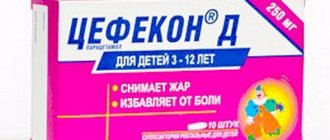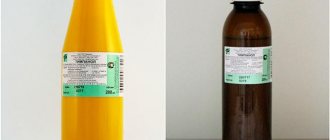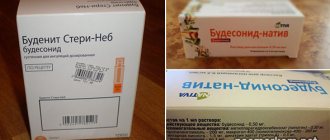To restore normal functioning of the respiratory tract, Salbutamol for inhalation is often prescribed. This drug is indispensable for pulmonary obstruction, when there is a need to urgently stop an attack and ease breathing.
However, despite its high effectiveness, Salbutamol has a number of contraindications, which are recommended to be familiar with before use.
Composition and release form
Salbutamol is produced by various pharmacological manufacturers, such as:
- Semashko,
- Beroteka,
- Binnopharm.
You can purchase this medication in the following forms:
- in the form of an aerosol for inhalation. More often this form is produced by Teva or Binnopharm. Salbutamol is dispensed in cans with a dispenser for 200 doses. This type of drug is most convenient for use,
- salbutamol solution for inhaler. Typically, this type of drug is packaged in ampoules and is intended for inhalation,
- powder. This type of drug is intended for a disc inhaler. The product is filled into a cyclohaler nebulizer.
The main active ingredient is salbutamol magnesium sulfate. The auxiliary substance is the propellant. Moreover, the product in question does not contain chlorofluorocarbon freons.
Salbutamol price
The price of Salbutamol aerosol depends on which company produced the drug and varies from 70 to 150 rubles. In Ukraine, the average price of a Salbutamol inhaler is 60 UAH.
Noting the high effectiveness of the drug from Moskhimfarmpreparaty OJSC and the fact that the drug has disappeared from pharmacies, many people with bronchial asthma are wondering where to buy Salbutamol Semashko in Moscow. Pharmacy staff advise looking for medicine on special forums and online pharmacies.
Sharing personal experience, many people say that you can try to buy Salbutamol Moscow in the regions. For example, one of the users wrote that he could not find the medicine in pharmacies in Moscow, but in one of the pharmacies in the suburbs it was sold in sufficient quantities.
- Online pharmacies in RussiaRussia
- Online pharmacies in UkraineUkraine
- Online pharmacies in KazakhstanKazakhstan
ZdravCity
- Salbutamol AB aerosol for injection.
dosage 100 mcg/dose balloon 200 dosesAltaivitamins ZAO 108 RUR order - Salbutamol aerosol. d/inhal. doses 100mcg/dose 90doses 12ml n1Altaivitamins JSC
48 RUR order
- Salbutamol Pharmstandard aerosol for inhalation dosed 100 µg/dose 200 doses bal. JSC "Pharmstandard-Leksredstva"
123 RUR order
- Salbutamol-Pharmstandard HF aerosol for inhalation dosed 100 µg/dose 200 dosesPharmstandard-Leksredstva OJSC
128 rub. order
- Salbutamol aerosol. d/inhal. doses 0.1 mg/dose 200 doses 12 ml n1AO Binnopharm
132 RUR order
Pharmacy Dialogue
- Salbutamol-MHPP (aerial d/ing. dose. 100 µg/dose 200 doses No. 1) MHPP
138 RUR order
- Salbutamol AB aerosol 100mcg/dose 200doses 7gAltaivitamins
99 RUR order
- Salbutamol-Teva aerosol 100mcg/dose 200doses 12mlNorton
128 rub. order
- Salbutamol aerosol 100 µg/dose 200 doses 12 ml Binnopharm
127 RUR order
- Salbutamol (aerial 100mcg/dose 90doses 12ml)Altaivitamins
37 RUR order
Europharm* 4% discount using promo code medside11
- Salbutamol aerosol for inhalation 100 mcg/dose 200 doses TevaNorton Waterford-Ivax Pharmaceuticals I
136 RUR order
- Salbutamol aerosol for inhalation 100 mcg/dose 90 doses altaivitaminsALTAIVITAMINS
68 RUR order
- Salbutamol aerosol for inhalation 100 mcg/dose 200 doses mkhfp semashkoJSC "Moskhimfarmpreparaty" named after. N
127 RUR order
- Salbutamol-av aerosol 100 mcg/dose 200 dosesAltaivitamins JSC
104 rub. order
- Salbutamol aerosol for inhalation 100 mcg/dose 300 doses AltaivitaminsAltaivitamins JSC
114 RUR order
show more
Pharmacy24
- Salbutamol-Neo 100 mcg/dose 12 ml/200 doses inhaler TOV "Mikrofarm", Kharkiv, Ukraine
58 UAH. order - Salbutamol 100 mcg/dose 200 doses aerosol for inhalation LLC "Multisprey", Ukraine
63 UAH order
- Salbutamol-Inteli 100 mcg/dose 200 doses 10 ml suspension
63 UAH order
- Salbutamol 10 ml 200 doses without freon aerosol
68 UAH order
PaniPharmacy
- SALBUTAMOL aerosol Salbutamol aerosol 0.1 mg/1 dose 10 ml 200 doses France, Glaxo Wellcome Production
78 UAH order
- Salbutamol neo aerosol Salbutamol-NEO aerosol 100 mcg/200 doses 12ml Ukraine, Microfarm LLC
67 UAH order
- SALBUTAMOL aerosol Salbutamol 100 mcg/dose 10 ml bottle. 200 doses Spain, Lab. Aldo-Union
71 UAH order
show more
Operating principle
As mentioned above, the active component of the drug in question is salbutamol magnesium sulfate. This substance, entering the bronchi, increases their lumen and relaxes the muscles. Due to this mechanism of action, a bronchodilator effect is formed, which improves bronchial patency.
After inhalation, a small part of the fine particles enters the small bronchi. The rest of the drug is located on the mucous membrane of the pharynx, trachea and larynx, and also enters the bloodstream.
It is worth noting that the instructions for using salbutamol explain that this drug is metabolized in the liver, forming inactive decay particles that leave the body along with urine. Therefore, this drug is contraindicated for patients with liver pathologies.
What diseases does it help against?
The drug salbutamol is prescribed to block a number of pathologies associated with bronchial obstruction. These include:
- bronchial asthma. With this pathology, the pulmonologist prescribes a complex of therapeutic measures, consisting of taking glucocorticosteroids and drugs based on the active substance salbutamol,
- for short-term relief and dilation of the bronchi with normalization of breathing, and reduction of shortness of breath during an obstructive attack,
- to block shortness of breath resulting from bronchial asthma accompanied by allergies,
- to relieve bronchospasms and other obstructive phenomena developing in the lung tissue.
The indication for use of the drug in question occurs not only during asthmatic attacks, but also in the following situations:
- for bronchitis, asthmatic and chronic origin,
- pulmonary ephysema,
- chronic obstructive pulmonary pathologies.
This medication has a positive effect on lung tissue. However, it should be emphasized that the use of salbutamol is aimed at temporarily eliminating negative phenomena; it does not treat the underlying cause.
List of contraindications
Salbutamol in aerosol form has a number of contraindications. The use of this drug is not recommended for the following factors:
- when there is a threat of losing a child,
- in the presence of toxicosis,
- intolerance to the active substance,
- heart failure,
- arterial hypertension,
- stenosis and heart defects,
- for pathologies of the heart muscle.
Pregnant women are allowed to use salbutamol under medical supervision. Moreover, before prescribing this medicine, the doctor assesses the potential risks to the fetus and, if the benefits outweigh the possible negative effects, the medicine is prescribed.
Contraindications
- Hypersensitivity to the components of the drug,
- cardiac ischemia,
- severe heart failure,
- rhythm disturbances (paroxysmal tachycardia, polytopic ventricular extrasystole),
- myocarditis,
- heart defects,
- aortic stenosis,
- decompensated diabetes mellitus,
- glaucoma,
- seizures,
- pyloroduodenal narrowing,
- diseases of the kidneys and liver with impairment of their function,
- pregnancy,
- simultaneous use of non-selective beta-blockers,
- children up to 18 months.
Side effects
As a rule, the use of salbutamol does not provoke the development of side effects. However, in some cases, the use of the medication in question can provoke the development of a number of negative phenomena, such as:
- nausea, vomiting, dizziness and pain,
- development of tachycardia transforming into dilatation of peripheral vessels,
- sometimes an allergic reaction may occur in the form of a rash on the skin, swelling or urticaria,
- sometimes hypokalemia may occur,
- anxiety attacks,
- cough and asthma attacks,
- decrease in blood pressure,
- general weakness and convulsions.
In addition, a patient using such a remedy sometimes experiences trembling, tremors, and in some cases muscle spasms.
Side effects
Is constant use of Salbutamol addictive or dependent? It is not recommended to use the medicine for a long time, without interruption, or to suddenly stop taking it, as this may cause an adverse reaction.
Negative manifestations after taking the medicine concern the functioning of the cardiovascular, nervous, and muscular systems.
It could be:
- imbalance in the contractility of the heart (extrasystole);
- involuntary muscle contractions;
- increased excitability.
Other disorders that appear after therapy with Salbutamol are a decrease in potassium levels, urinary retention, increased sweating, and a gag reflex. In some cases, signs of allergies are observed in the form of urticaria, Quincke's edema, and sudden attacks of suffocation.
The drug, when used during pregnancy, overcomes the placental barrier.
Rules for taking for various diseases
Pathological diseases of the respiratory system lead to a decrease in the capacity of the lung tissue. To prevent such a negative phenomenon, salbutamol is prescribed. However, it must be emphasized that depending on the severity of the disease, this medication can be prescribed in a certain most appropriate form:
- with a mild form of the obstructive phenomenon, inhalation using an aerosol is indicated,
- if the patient's condition is severe, the single dose may be increased. In addition, it is permissible to dilute the medication with saline solution and administer it by injection,
- if the medicine is used in powder form, it is administered using a disc inhaler. This form is indicated for pathologies of moderate severity.
As for the dosage, method of dilution and amount of medication taken, they are prescribed by the attending physician. In addition, before using salbutamol, you should carefully read the instructions for any contraindications.
Exceeding the dose of the drug
First of all, exceeding the dosage is fraught with the development of negative side effects. Therefore, the patient must strictly adhere to the medical prescription.
In the event that the prescribed dose has been exceeded, the patient experiences the following phenomena:
- arrhythmia,
- tachycardia,
- hyperactivity,
- tremor.
In case of overdose, it becomes necessary to discontinue the drug or replace it with an analogue. In addition, excessive intake of the drug develops hypokalemia, as a result of which it is important to control potassium in the serum of biological fluid.
Interaction
Salbutamol is not recommended for use simultaneously with the following groups of drugs:
- medicinal forms, the action of which is aimed at treating angina pectoris. The combined use of such drugs leads to suppression of the therapeutic effect,
- theophylline. With complex use, there is a high probability of arrhythmia and tachycardia,
- diuretics. With this combination, there is a risk of potassium being washed out of the blood.
If a patient is prescribed the use of salbutamol and is taking one of the above drugs, the doctor should be informed about this. The specialist will select a substitute that does not inhibit the effect of accompanying medications.
With other medicines
In addition to the groups described above, salbutamol should not be used in tandem with central nervous system stimulants, so as not to provoke an increase in the activity of thyroid hormones. It is also not recommended to use corticosteroids and tricyclic antidepressants simultaneously with the drugs in question, since such a complex can increase the likelihood of developing cardiovascular complications.
With alcohol
The use of the drug in question after or before drinking alcoholic beverages is unacceptable. Alcohol completely neutralizes the inhalation effect of the drug. Moreover, there is a risk of developing negative phenomena.
Directions for use and dosage
The drug is intended exclusively for inhalation administration.
Inhalations more than 4 times a day are not recommended. The need to increase the frequency of use of the drug or to suddenly increase the dose is confirmation of the worsening of the disease.
Recommended dosage regimen of Salbutamol for children and adults:
- Relieving an attack of bronchospasm: 100-200 mcg (1-2 inhalations);
- COPD and long-term maintenance treatment for bronchial asthma (as part of combination therapy): in a single dose of no more than 200 mcg (2 inhalations) 4 times a day;
- Prevention of bronchospasm attacks caused by physical activity or exposure to an allergen: 10-15 minutes before the action of an irritating factor or physical activity, children are administered 100-200 mcg (1-2 inhalations), adults – 200 mcg (2 inhalations).
The decision to increase the dose or frequency of use of the drug is made only by the attending physician.
Elderly persons do not require dose adjustment.
Before using Salbutamol for the first time, you must remove the protective cap from the inhaler nozzle, vigorously shake the container up and down, and to check the adequate operation of the valve, spray 2 times into the air. When taking a break from using the aerosol, after vigorous shaking, one spray should be sprayed into the air.
To administer the drug, after removing the protective cap from the inhaler nozzle and checking the cleanliness of its internal and external surfaces, shake the container carefully. Then hold it in a vertical position (nozzle down) between the thumb, middle and index fingers, while the thumb should be located under the inhaler nozzle.
After exhaling as deeply as possible, the nozzle is placed in the mouth between the teeth, covering it with the lips, but without biting. After this, take a slow and deep breath through the mouth, dispensing a dose of the product by pressing the top of the balloon. To achieve the maximum effect of the drug, you need to inhale air as slowly as possible. Holding your breath as long as possible, remove the nozzle from your mouth and remove your finger from the top of the balloon.
If necessary, the next inhalation is carried out after 30 seconds, holding the balloon vertically. After completing the procedure, the inhaler nozzle is closed with a protective cap.
It is advisable to use Salbutamol the first few times after training in front of a mirror; if a “cloud” appears on the sides of the mouth, inhalation should be carried out first.
It is recommended to clean the inhaler nozzle at least once every seven days; to do this, remove it and the protective cap from the cylinder and rinse thoroughly under warm running water. Then, after drying the washed parts outside and inside, the nozzle is placed on the cylinder and valve stem, closing its free hole with a protective cap.
The cylinder must not be placed in water.
Features of treatment
The dosage of an aerosol medication largely depends on the age category of the patient, the clinical picture and the individual characteristics of the body. The instructions indicate general indications. Therefore, to determine the exact most appropriate dosage, you should consult a doctor.
According to the dosage regimen, salbutamol is recommended to be used as follows:
- for severe bronchospasm, accompanied by a dry cough and difficult to separate sputum, 3-5 injections per day are recommended. In this case, the first 2 times you need to breathe the medicine with a break of 5 minutes,
- if the patient has a moderate degree of pathology, spraying the product is indicated 3-4 times a day,
- As a preventive measure, salbutamol is used 2 times, morning and evening.
It is worth noting that depending on the general condition of the patient, the daily dosage may be increased or, conversely, decreased. As for the duration of therapy using the drug in question, this point is agreed with the attending physician depending on the patient’s condition.
Children
The child may also be prescribed salbutamol. This drug is highly effective for laryngitis accompanied by acute bronchospasm. You can use the hormonal drug starting from two years of age. The dosage and frequency are determined strictly taking into account the age and weight category.
During pregnancy and pregnancy
The description of the drug states that salbutamol is prescribed to women during pregnancy if the expected benefit is many times greater than the potential danger to the unborn baby. However, if the expectant mother experiences such phenomena as:
- risk of miscarriage,
- possibility of placental abruption,
- bleeding,
- toxicosis.
This dosage form is contraindicated. In addition, the use of salbutamol during breastfeeding is not advisable. Because the active ingredient passes into breast milk. Moreover, if there is an urgent need to use the medication in question, it can be prescribed, but under the strict supervision of a doctor.
special instructions
In patients with severe or unstable bronchial asthma, the use of bronchodilators should not be the main or only method of therapy.
If the effect of the usual dose of the drug becomes less effective, the patient should consult a doctor.
If paradoxical bronchospasm occurs, it is necessary to immediately stop it with another dosage form of salbutamol or a fast-acting inhaled bronchodilator, stop treatment and prescribe therapy with other drugs.
Analogues of the drug
If the patient has contraindications for the use of salbutamol, the doctor may recommend the use of a structural analogue. Most often, the product is replaced with the following forms:
- Ventolin. There are several forms of release of this medication on sale, an aerosol for inhalation and nibules for an inhaler. A remedy is indicated for the relief of asthmatic attacks, the treatment of chronic lung pathologies, such as obstruction, COPD and other defects of lung tissue. In addition, ventolin is a hormonal agent. Therefore, it is recommended to take it in short courses, so as not to provoke addiction.
- Berodual. An effective drug available in the form of a solution for inhalation. This medicine is indicated even for infants. It is not addictive, is not hormonal and has fewer contraindications.
- Bromhexine. Another drug recommended for the treatment of pulmonary pathologies. The product is available in the form of capsules, inhalation solution and syrup. Bromhexine has the same indications as salbutamol. However, it takes longer to achieve maximum effect. In view of this, the remedy is indicated as a prophylaxis.
- SamaComb. A combined medication dispensed in the form of an aerosol. The drug contains an adrenergic agonist and a glucocorticosteroid. Indications for use are identical to salbutamol. But this type of medicine is contraindicated for children and expectant mothers.
- Salgim. A prescription drug that has a relaxing effect on smooth muscles, relieves bronchial attacks, including obstruction and other lung pathologies. The disadvantages of this remedy include a negative effect on the heart.
- Guaifenesin. One of the most effective medications of natural origin. This dosage form is combined and has a number of positive effects. It relieves attacks of suffocation, helps alleviate the patient’s condition with chronic lung pathologies and is not addictive. Available in the form of tablets and syrup.
- Formoterol. A selective stimulant prescribed for obstruction, acute bronchitis, COPD and other pulmonary pathologies. Dispensed in the form of an aerosol for inhalation. Formoterol quickly stops attacks, however, it is not recommended to use it for a long time.
The drug in question can be replaced with an analogue only as prescribed by the attending physician. Doing this on your own is strictly prohibited, as there is a high probability of worsening the condition.
Instructions for use of Salbutamol
For patients over 12 years of age, the daily dose of Salbutamol in dosage forms intended for oral administration ranges from 6 to 16 mg. It is recommended to divide it into 3-4 doses. In cases where this is necessary, the daily dose may be increased to 32 mg with a frequency of applications 4 times a day.
For children from 6 to 12 years old, Salbutamol 2 mg 3 or 4 times a day is indicated; for patients from 2 to 6 years old, the optimal dose is 1-2 mg with a frequency of applications 3 times a day.
When administered by inhalation, the dose depends on the prescribed dosage form. In accordance with the instructions for use, Salbutamol aerosol is prescribed to relieve bronchospastic syndrome or an attack of bronchial asthma. For adults, the spray is usually recommended to be administered at 0.1-0.2 mg, for children - at 0.1 mg.
The frequency of procedures depends on the clinical situation and indications.
In order to prevent an attack of bronchial asthma associated with physical stress, before physical activity, Salbutamol aerosol is administered to children in a dose of 0.1 mg, for adults - 0.2 mg. The highest daily dose is 0.8 mg (corresponds to 8 inhalations).
The medicine, available in powder form, should be used according to a similar scheme, but with a corresponding doubling of the dose.
The solution for inhalation is used in a dose of 2.5 mg 3 or 4 times a day. If appropriate, it is possible to increase the dose to 5 mg with the same frequency of applications.
Instructions for use of the Salbutamol inhaler
Before using the inhaler, you should check its functionality. This procedure is also recommended if the patient has not used it for some time.
- It is necessary to remove the cap from the inhaler and make sure that the outlet tube is not clogged with dust or dirt.
- While holding the can in a vertical position, place your thumb under the bottom and your index finger on its top, after which you need to vigorously shake the can up and down several times.
- After taking a deep breath (it is recommended to inhale without straining), you should throw your head up and tightly pinch the outlet tube of the inhaler with your lips.
- Holding the tube with your lips, you should take a slow, deep breath, while simultaneously pressing your index finger (in the first third of your inhalation) on the valve of the inhaler can and releasing a dose of medication. The air continues to be inhaled slowly.
- Having removed the canister tube from your mouth, you need to hold your breath for 10 seconds (or as long as possible without straining), and then slowly exhale through your nose.
- If you need to take more than one dose of Salbutamol, wait for about a minute after the first inhalation and then repeat all the steps described above (starting from the second point). After completing the procedure, the can should be closed with a cap.
When releasing a dose of medicine, you should not rush; to achieve maximum effect, you need to inhale the air as slowly as possible. It is optimal to practice a little in front of a mirror before the procedure.
If during inhalation steam comes out from the top of the inhaler or from the corners of the mouth, you must start inhalation again from the second point.
How to clean the inhaler?
The inhaler must be cleaned at least once a week. The can is removed from the plastic case, after which the case and cap are washed with warm water (not hot!).
Washed parts should be dried thoroughly without using heating devices. After this, the can is again placed in the case and closed with a cap.
Do not dip the metal can into water.










